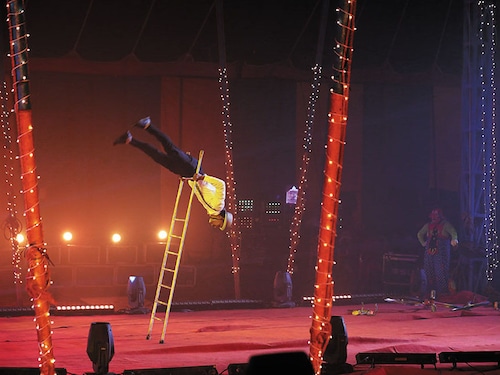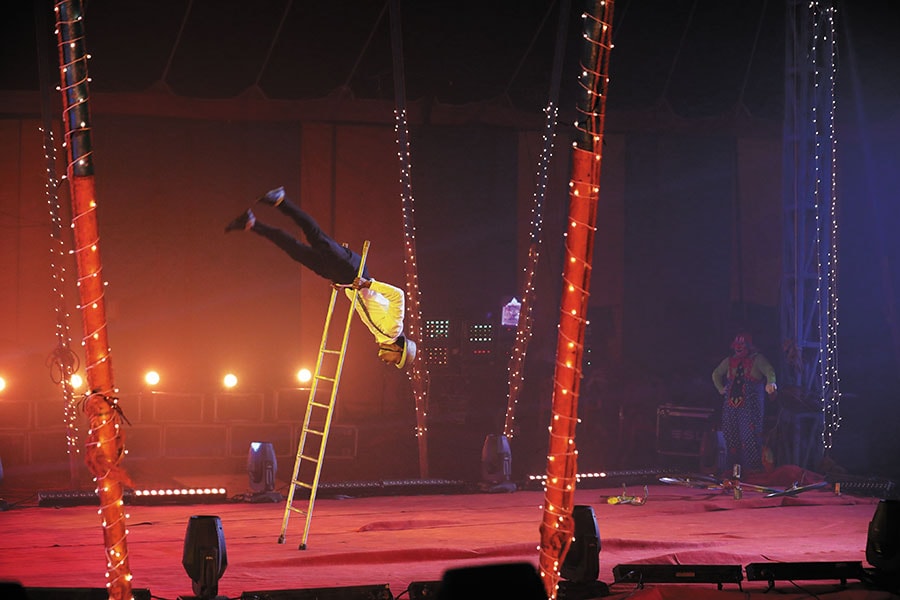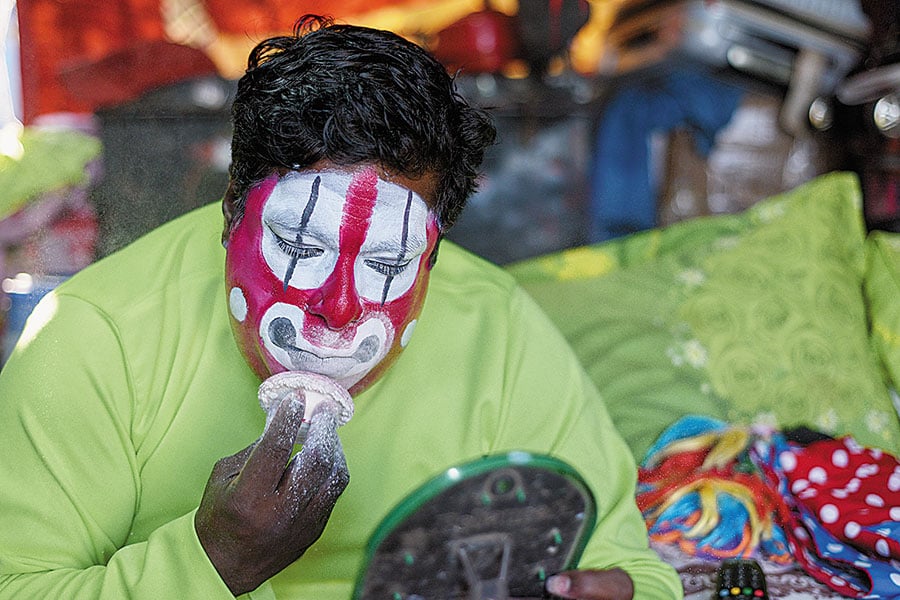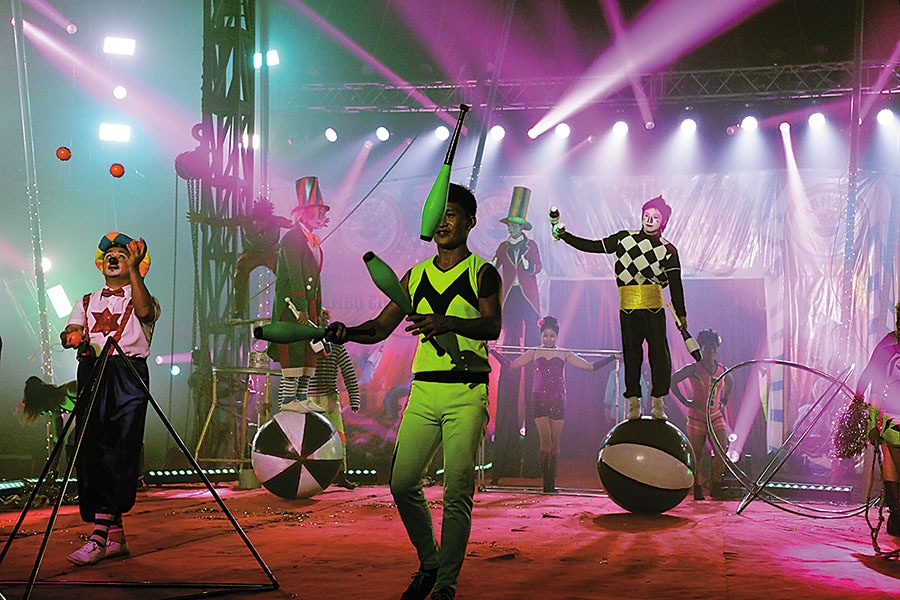How Rambo Circus went online
The legendary circus act turned to digital streaming to stay afloat during the pandemic


 With 34 shows and a 60,000-plus viewership, ‘Life Is A Circus’ earned ₹21 lakh for Rambo in ticketing revenues and online donations
With 34 shows and a 60,000-plus viewership, ‘Life Is A Circus’ earned ₹21 lakh for Rambo in ticketing revenues and online donations
Image: Laqshya Live Experiences and Production Crew[br]In the backyard of a local vegetable market in Navi Mumbai’s Airoli, on the outskirts of Mumbai, the blue and yellow Big Top of Rambo Circus stands out like a ghost town. Perhaps emblematic of the industry it represents, the grass is unkempt, the lights are off and the usual hubbub is missing only a handful of curious urchins stop by as the bespectacled clown, in his polka-dotted overalls, steps out for a phone call.
Inside the barebones tent, though, owner Sujit Dilip is anything but downcast. A burly man of 45, who survived Covid-19 along with his father in June, Sujit explains the emptiness: “It’s because most of our artistes have gone home to their families to celebrate Dussehra and Diwali after years,” he says. “We were able to distribute some money from our recent shows among 82 staff members, after being shut since March once the national lockdown was announced.”
Sujit’s optimism isn’t entirely misplaced. The circus, launched in 1991 by his father PT Dilip by merging three smaller ones (the name Rambo referring to its new size), is fresh off a successful digital-only show, possibly the first-of-its-kind in the world for a genre that is built around live, immersive experiences. The 45-minute pre-recorded event, scripted by events and experiential media company Laqshya Live Experiences and their partners Production Crew, was streamed on BookMyShow, Rambo’s ticketing partner for 12 years, beginning the last week of September. When it wrapped up its season around the Diwali weekend in November, ‘Life Is A Circus’ logged 34 shows with a viewership of 60,000-plus, raising almost ₹21 lakh for Rambo in ticketing revenues and online donations. By the sheer number of tickets sold, Rambo has become the highest-selling virtual show on the ticketing platform. The windfall came after seven months of zero earnings, surviving merely on doles, charity and ₹12.38 lakh that Sujit raised with an appeal on crowdfunding platform Ketto.
For Sujit, this is one of the rare silver linings of the dark cloud that has been chasing him since the demonetisation that was announced in November 2016. “For about six months after demonetisation, people only had time to queue up in front of ATMs to collect cash. Who would come to watch the circus?” he asks. The following July, the Goods & Service Tax was introduced and it “was another blow for us”. But it is 2019 that Sujit calls his annus horribilis, thanks to inclement weather. Heavy rains and floods swept the country, claiming 1,685 lives of which, according to a report by the Ministry of Home Affairs, 22 percent were in Maharashtra. “Our tents were flooded, and equipment destroyed. It was worse than Covid-19,” says Sujit. Coming on the back of these, Covid was indeed the proverbial last nail in Rambo’s coffin.
Not just Rambo, the world over too, circuses have been surviving only just. American circus Barnum & Bailey shut shop in 2017, after 146 years. This June, Montreal-based Cirque Du Soleil announced it was laying off about 3,500 employees and suspending shows following financial difficulties triggered by the pandemic. Anecdotal evidence suggests a number of small circuses in India have closed over the past decade due to waning audiences and rising costs. The number of circuses going under is only expected to rise post-Covid.  Biju Pushkaran, a clown with Rambo Circus for 20 years, does his own make-up before a show
Biju Pushkaran, a clown with Rambo Circus for 20 years, does his own make-up before a show
Image: Mexy Xavier[br]In a typical month, Sujit spends over ₹20 lakh (depending on the city they are in) to keep the circus running ₹15-16 lakh is for salaries (for a 45-day stint in a location), while rent, utilities, marketing, and medical expenses add up for the rest. Ticketing is the only source of revenue and he banks on the economies of scale, sometimes selling for as low as ₹80 per person. “We stay in a city for 45 days. If we get 3,000 people in a day, it more than makes up for our expenses. We had two tents in Mumbai, in Malad and Sanpada, in 2018. The returns were so good that we were able to pay salaries from the surplus when rains played havoc with our shows in 2019,” he says.
When the lockdown was announced in March, Rambo had already invested in a publicity blitz on buses, hoardings, posters for its upcoming shows—it all came a cropper. In the early days, it sent its elderly staff, involved in marketing and front-of-office operations, home. When the shows were cancelled, “I thought I would have to shut the circus, but our artistes told me they had nowhere else to go”.
It was then that politicians like Nationalist Congress Party leader and state minister Chhagan Bhujbal, Navi Mumbai Municipal Corporation opposition leader Vijay Chougule and local Good Samaritans came forward with food and donations to keep the staff going. One among them was a staff member of Laqshya who met Sujit, and began a conversation on how they could stay afloat in the crisis. Says Saurabh Khurana, senior vice president, national, Laqshya Live Experiences: “When my colleague came back, we realised we weren’t a big enough organisation ourselves to keep pumping money into Rambo. We thought instead of making donations, why not invest in our core competency—creating events and experiences. If the audiences couldn’t come to the circus, why not take the circus to them?”
But transforming a live act into a camera-friendly one isn’t easy—it had to straddle the fine line between fancy and rustic, one that evoked nostalgia in the older generations that had grown up with circuses and awe in younger ones for whom it remains a novelty. With strict Covid-19 protocols in place, Laqshya set off for Rambo’s tent in Airoli, where they set up five cameras—four stationary and one moving—and deployed choreographer Rahul Saxena to turn Rambo into a compact, visually pleasing show. Rambo Circus’s online foray has become the highest-selling virtual show on BookMyShow
Rambo Circus’s online foray has become the highest-selling virtual show on BookMyShow
Image: Laqshya Live Experiences and Production Crew[br]“The brief that they set for me,” says Saxena, “was to polish the rawness of the acts. The digital show needed to have more attitude.” Which means the performers, who were given to bumbling in and out of the stage at the beginning and end of their act, had to add more sass and shimmy. “Instead of running in straight, join in a sequence, go criss-cross, wave, smile, what have you,” adds Saxena. “A gymnast performs her entire routine, from start to finish, with a flourish. This is what I was looking to get the circus artistes to do.”
With roughly 5 minutes scheduled for each act, some were ditched, and some merged. For instance, the canine act was dumped (much to the dismay of Mumbai siblings Grace and Mark D’Souza who wanted to catch each act they had seen live in the “dome tent” in January), while the jugglers and acrobats performed in tandem in a single act.
When Biju Pushkaran, a clown with Rambo Circus for 20 years, was called onto the stage for his shot, he was flummoxed. Used to running out with kids squealing “joker aaya [the joker is here]”, and building acts intuitively, like calling grumpy men onstage and getting them to publicly profess love for their wives, Pushkaran didn’t know what to do in an empty tent. “The director kept on saying, ‘Biju, kuch bolo [ Biju, say something],’ but I didn’t know what to do in the absence of audiences. It was then that the director pointed to the camera and told me that was my audience, that through this, I was reaching thousands of people at one go,” says Pushkaran, who has performed in Zoya Akhtar’s 2009 film Luck By Chance. “It worked well, the new acts had me rolling over with laughter.”
The team rehearsed for a day and had shoots for two days in end-August, spending around 20 hours each day on site. At times, the shoots had to be interrupted to eliminate the sound of pouring rain or water gushing in. Besides, a few acts had to be repeated to catch the most fetching camera angles. “But the artistes did it uncomplainingly,” says Khurana, “We had aerial shots and close-ups, which you don’t see in a live show. We also had TV actor Vipul Roy as the narrator. The final act was like a carnival where all the artistes came together on the floor and passed on the message that the show must go on.”
The Laqshya-Rambo-BookMyShow collaboration also brought on board add-on services like a meet-and-greet with the clown. Conducted over a Zoom call, with Pushkaran decked up in greasepaint and stationed at Laqshya’s Mumbai studio, the experience made wonderment tangible for kids logging in from across India as well as from Australia and Saudi Arabia. “It was a joy to answer innocent questions like, ‘Joker, what do you eat?’, or ‘Who all are there in your family?’” says Pushkaran. 
As Sujit packs off for the year, he’s waiting for the government to furnish new standard operating procedures for live shows. He admits that the digital event has caught his fancy and he is exploring options to follow a hybrid model in future, where he can invite audiences back to the tent as well as reach out to a wider audience online.
So is his ticketing partner BookMyShow, which is working on a blueprint to elevate the circus viewing experience. “For us, it’s important to create value for society. We want Rambo Circus to be self-sustaining,” says Ashish Hemrajani, founder and CEO of BookMyShow. “We brought Cirque du Soleil to India and were the promoters of the show. We want to take those learnings and improve the customer experience—be it air-conditioned tents, food and beverages, security services, clean toilets, fancy costumes—and up the scale where the revenues from the circus can rise easily.” In fact, Cirque du Soleil, which had earlier filed for bankruptcy, is looking to reopen, hoping to turn around with fresh capitalisation, better audience experiences and move into new markets.
The online gig has opened for BookMyShow newer markets and avenues to grow the category. Hemrajani is now looking to parse the demographics of his digital audience, and foray into those markets to create an upgraded, physical circus experience for them. “It will require some capital expenditure to bring in newer acts in collaboration with foreign artistes,” he says. “It’s a work in progress and there are still many open-ended questions. But we are keeping ourselves prepared.”
The magic of travelling artistes isn’t new for Sujit. He recalls the time a Russian acrobat taught one of his performers how to take three somersaults at one go, in return for a bottle of vodka. “The trick was to pull his knees into the sides of the body and not into his chest,” he says. Will Rambo Circus leap into a 2.0 avatar as seamlessly once the world opens up? Only time will tell.
First Published: Dec 10, 2020, 14:29
Subscribe Now